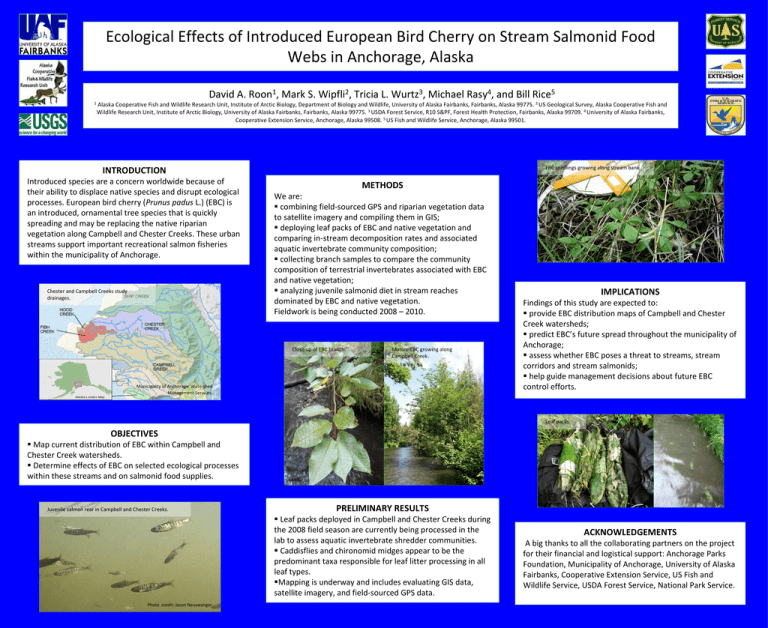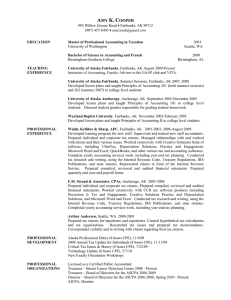Ecological Effects of Introduced European Bird Cherry on Stream Salmonid... Webs in Anchorage, Alaska
advertisement

Ecological Effects of Introduced European Bird Cherry on Stream Salmonid Food Webs in Anchorage, Alaska David A. Roon1, Mark S. Wipfli2, Tricia L. Wurtz3, Michael Rasy4, and Bill Rice5 1 Alaska Cooperative Fish and Wildlife Research Unit, Institute of Arctic Biology, Department of Biology and Wildlife, University of Alaska Fairbanks, Fairbanks, Alaska 99775. 2 US Geological Survey, Alaska Cooperative Fish and Wildlife Research Unit, Institute of Arctic Biology, University of Alaska Fairbanks, Fairbanks, Alaska 99775. 3 USDA Forest Service, R10 S&PF, Forest Health Protection, Fairbanks, Alaska 99709. 4 University of Alaska Fairbanks, Cooperative Extension Service, Anchorage, Alaska 99508. 5 US Fish and Wildlife Service, Anchorage, Alaska 99501. EBC seedlings growing along stream bank. INTRODUCTION Introduced species are a concern worldwide because of their ability to displace native species and disrupt ecological processes. European bird cherry (Prunus padus L.) (EBC) is an introduced, ornamental tree species that is quickly spreading and may be replacing the native riparian vegetation along Campbell and Chester Creeks. These urban streams support important recreational salmon fisheries within the municipality of Anchorage. Chester and Campbell Creeks study drainages. METHODS We are: combining field-sourced GPS and riparian vegetation data to satellite imagery and compiling them in GIS; deploying leaf packs of EBC and native vegetation and comparing in-stream decomposition rates and associated aquatic invertebrate community composition; collecting branch samples to compare the community composition of terrestrial invertebrates associated with EBC and native vegetation; analyzing juvenile salmonid diet in stream reaches dominated by EBC and native vegetation. Fieldwork is being conducted 2008 – 2010. Close up of EBC branch. Mature EBC growing along Campbell Creek. Municipality of Anchorage: Watershed Management Services. IMPLICATIONS Findings of this study are expected to: provide EBC distribution maps of Campbell and Chester Creek watersheds; predict EBC’s future spread throughout the municipality of Anchorage; assess whether EBC poses a threat to streams, stream corridors and stream salmonids; help guide management decisions about future EBC control efforts. Leaf packs. OBJECTIVES Map current distribution of EBC within Campbell and Chester Creek watersheds. Determine effects of EBC on selected ecological processes within these streams and on salmonid food supplies. Juvenile salmon rear in Campbell and Chester Creeks. PRELIMINARY RESULTS Leaf packs deployed in Campbell and Chester Creeks during the 2008 field season are currently being processed in the lab to assess aquatic invertebrate shredder communities. Caddisflies and chironomid midges appear to be the predominant taxa responsible for leaf litter processing in all leaf types. Mapping is underway and includes evaluating GIS data, satellite imagery, and field-sourced GPS data. Photo credit: Jason Neuswanger ACKNOWLEDGEMENTS A big thanks to all the collaborating partners on the project for their financial and logistical support: Anchorage Parks Foundation, Municipality of Anchorage, University of Alaska Fairbanks, Cooperative Extension Service, US Fish and Wildlife Service, USDA Forest Service, National Park Service.








